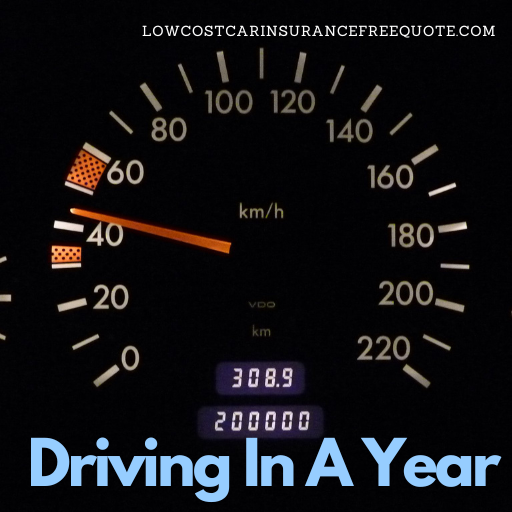The average Miles Driven Per Year and Get Compare Quotes
What is the average miles driven per year?
The Federal Highway Administration of the US Department of Transportation states that the average person drives about 13,500 miles each year.
This is the highest average miles per year in American history. Equivalent to over 1000 miles every month.
Average Miles Driven Per Year
The US Department of Transportation’s Federal Highway Administration said the average person drove 14,263 miles per year in 2019. That’s about 1,200 miles per month per driver, or about 39 miles per day. In comparison, the DOT stated that the average annual mileage in 2018 was 13,476.

People rely on their cars because public transportation varies by location. Without major public transportation systems that many Americans can rely on, automobiles allow many drivers to get to work, school, or play.
According to the US Department of Transportation’s Federal Highway Administration, Americans drove more than 3.26 trillion miles in 2019.
That number has dropped drastically since the enforced lockdowns of the COVID-19 pandemic starting in 2020. At that point, the DOT said average miles driven per year were down 10.3%.
The Average Miles Driven Per Year By Age Group
| Sl No. | Age | Male | Female |
| 1. | 35 to 54 | 18954 | 11458 |
| 2. | 55 to 64 | 15869 | 7748 |
| 3. | 65 to 74 | 10478 | 4758 |
| 4. | 75 + | 16557 | 10568 |
How Does Annual Mileage Affect Insurance Rates?
Your annual mileage directly affects how much you pay for car insurance. Drivers who spend more time on the road have a higher risk of reporting an insurance claim than infrequent drivers who are less likely to have an accident.
Insurance companies use the number of miles you drive each year — along with other criteria like age and experience — to predict your risk and set your premium accordingly. Typically, insurers ask for average miles driven per year when drivers apply for a policy. It’s best to make an honest mileage estimate of how much you drive.
Even if underestimating the annual mileage in the application does not result in any legal consequences, it could become problematic if you are involved in an accident. In the event of a claim, the insurer learns the mileage of the vehicle.
Some companies request mileage updates. Other airlines may do random mileage checks to avoid “soft cheating” when numbers are below average.
Be sure to inform your insurer if your driving situation changes. A shorter commute may result in a lower premium. Whether you’re commuting, traveling for business or pleasure, the way you drive affects how much you pay for auto insurance coverage.
Is 15,000 Miles A Year A Lot?
A general rule of thumb to keep in mind, especially when looking at reports like Carfax or AutoCheck, is that 15,000 miles per year is considered to be the industry average.
So, if you’re looking at a vehicle that’s ten years old, it’s not unreasonable for it to have between 100,000 and 150,000 miles.
What Is The Average Miles Driven Per Year Of A Car In The UK?
8,000 per year
The best way to calculate your mileage
So in UK average miles driven per year is less than 8,000 per year, but our figures suggest that people round to 10,000 when that’s not really necessary.
How Many Miles Should You Put On Your Car Per Year?
Putting between 12,000 and 15,000 miles on your car per year is generally considered “average.” A car that is driven more than that is considered high mileage. With proper maintenance, cars can have a useful life of approximately 200,000 miles.
Can A Car Last 500,000 Miles?
Today, a million miles, or even 500,000 miles, is still extremely unusual for a vehicle. Consumer Reports, through its annual questionnaire, has found that thousands of people have driven more than 200,000 miles in their original vehicles without catastrophic failures or major repairs.
Should You Buy A Car With 150,000 Miles?
It’s okay to buy a car with more than 150,000 miles, but it can be expensive. It can also be a great bargain. If the car is in good condition and is unlikely to have major repairs soon, it might be worth buying for the right price.
Pros and Cons of Car Insurance By The Mile
Auto insurance, also called auto insurance, is used to cover the cost of repairs when a car is damaged and the medical costs of those injured in an accident.
Insurance is not necessarily cheap and is more expensive for inexperienced drivers, older drivers, those who have had an at-fault accident, or drunk driving violations.

Auto insurance is also higher for those who drive more miles per year, live in dense urban areas, and own cars that are popular with auto thieves.
Auto insurers have begun offering insurance per mile as an alternative to the standard means of paying for auto insurance. However, instead of the above forms that simply ask how far and where you drive each year, they actually keep track of the number of miles traveled.
The vehicle insurance is then billed based on your risk rate per mile multiplied by the number of miles, along with the risk premiums for entering highly hazardous areas.
What Do Insurance Companies Consider Low Mileage?
Infrequent drivers can make savings by driving less than the average miles driven per year. Insurers typically give the highest discounts to drivers who drive their vehicles less than 7,000 miles a year.
Low mileage car insurance works by electrically tracking mileage, either with a telematics device installed in the vehicle or via a mobile app installed on your smartphone. The premiums for this type of insurance include a flat monthly fee and a small fee per mile.
Some motorists may have privacy concerns about tracking, while others find the cost savings outweigh any perceived intrusion. But no worry; They don’t care about where you’re going, just how many miles it takes you to get there.
Select insurers offer standalone low-mileage policies, or you can enroll in mileage-based discount programs through a standard insurer.
Car Insurance Rates and Quotes
If the car stays in the garage for a month or in the auto repair shop, the invoice will be automatically adjusted down to the driver in the next billing period. For those who drive only to run local errands or close to home, the rate will be appropriately reduced.
This can be a much lower rate than those based on stretches of 10,000 miles or less driven per year and more than 10,000 miles driven per year.
A single long trip will increase your car insurance rate, even if the area itself is safe. There are privacy concerns when using Global Positioning System (GPS) devices used for insurance by mileage programs.
For example, the car insurance company now has the means to know that someone drove and stopped in front of a gentlemen’s club; They get this information by knowing where the car is at all times.
Mileage car insurance information can be used to determine how fast someone was driving. By comparing the miles driven to the timestamp of the two mileage readings, the car longevity average miles per hour calculation can be made. The insurance company may increase the rates based on the suspected speeding, even if an actual speeding ticket was not issued.
Car Longevity and Service Life

The longevity of the car is of interest to many car owners and refers to several things: maximum service life in mileage or time (duration), relationship of components to this service life, identification of factors that can allow control to extend the useful life.
Barring an accidental end of life, a car would have a life limited by the earliest part to fail. Some have argued that rust and other factors related to a car’s body are the main limits to increased longevity.
Does Increased Average Miles Driven Per Year Affect Car Prices?
The national average annual mileage in 2011 was almost 4,000 miles below the last average in 2019. This increase in annual miles is also impacting the way Americans are buying cars and making more economical and electric vehicle choices.
When you sell a car, high or low mileage affects the selling price, along with the depreciation of the vehicle and a variety of other factors.
Drivers who lease their vehicle need to know how many kilometers they drive. Lease agreements typically have an annual mileage allowance of 10,000 miles or 12,000 miles. However, high mileage leases are available. This type of lease costs more, allowing Americans to drive additional miles without exceeding their lease terms.
FAQs about Car Insurance
How Many Kilometers Does the Average Person Drive Per Year?
According to the latest 2019 data from the US Department of Transportation’s Federal Highway Administration, the average miles driven per year in the United States is approximately 14,263.
What is the National Average Commute to Work?
The US The Census Bureau reports that the average one-way commute time in 2019 was 27.6 minutes, up from 25 minutes in 2006. 2019 data from the Federal Highway Administration shows that drivers in the US drive an average of 39 miles per day.
Why is Average Mileage Per Year Important?
The more you drive, the more likely you are to be involved in an accident. Auto insurance companies use average miles driven per year data to set premiums by predicting the risk of you making a claim.
When buying a used car, you can use the information to determine whether a vehicle has been driven below or above average.
When selling a used vehicle, a vehicle with higher mileage is likely to fetch a lower selling price.
When leasing a vehicle, agreements typically provide for an annual mileage allowance of 10,000 miles or 12,000 miles. High-mileage leases are available but cost more, allowing Americans to drive additional miles without exceeding their lease terms.